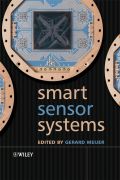
Providing a comprehensive review of recent developments in the field of smartsensor systems, Smart Sensor Systems discusses all of the important aspects of sensor systems, measurement techniques, microcontrollers, and testing and identification. Written with an applications focus by an internationally recognized team of contributors, the book presents a number of case studies along with a set of problems at the end of each chapter that enhance the book's appeal to undergrad and graduate students and engineers looking to design new sensor system applications. INDICE: Preface About the authors 1.Smart sensor systems Why? Where? How? Han Huijsing 1.1 Third industrial revolution 1.2 Definitions for several kindsof sensors 1.3 Automated production machines 1.4 Automated consumer products 1.5 Conclusion References 2 Interface electronics and measurement techniques for smart sensor systems Gerard Meijer 2.1 Introduction 2.2 Object-oriented design of sensor systems 2.3 Sensing elements and their parasitic effects 2.4 Analog-to-digital conversion 2.5 High accuracy over a wide dynamic range 2.6 A universal transducer interface 2.7 Summary and future trends Problems References3 Silicon sensors: an introduction Paddy French 3.1 Introduction 3.2 Measurement and Control systems 3.3 Transducers 3.4 Transducer technologies 3.5 Examples of silicon sensors 3.6 Summary and future trends References 4 Optical sensors based on photon detection Reinoud Wolffenbuttel 4.1 Introduction 4.2 Photonabsorption in silicon 4.3 The interface: photon transmission into silicon 4.4Photon detection in silicon photoconductors 4.5 Photon detection in silicon pn junctions 4.6 Detection limit 4.7 Photon detectors with gain 4.8 Applicationexamples 4.9 Summary and future trends Problems References 5 Physical chemosensors Michiel Vellekoop 5.1 Introduction 5.2 Physical chemosensing 5.3 Energy domains 5.4 Examples and applications 5.5 Examples of in-situ applications 5.6Microfluidic devices 5.7 Conclusions Problems References 6 Thermal sensors Sander van Herwaarden 6.1 The functional principle of thermal sensors 6.2 Heat-transfer mechanisms 6.3 Thermal structures 6.4 Temperature-difference-sensing elements 6.5 Sensors based on thermal measurements 6.6 Summary and future trends Problems References 7 Smart temperature sensors Gerard Meijer 7.1 Introduction 7.2 Application-related requirements and problems of temperature sensors 7.3 Resistive temperature-sensing elements 7.4 Temperature-sensor features of transistors 7.5 Smart temperature sensors and systems 7.6 Case studies of smart-sensor applications 7.7 Summary and future trends Problems References 8 Capacitive sensors Xiujun Li and Gerard Meijer 8.1 Introduction 8.2 Basics of capacitive sensors 8.3 Examples of capacitive sensors 8.4 The design of electrode configurations 8.5 Reduction of field-bending effects: segmentation 8.6 Selectivity for electrical signals and electrical parameters 8.7 Summary and future trends Problems References 9 Integrated Hall Magnetic Sensors Pavel Kajik and Radivoje Popovic 9.1 Introduction 9.2 Hall effect and Hall elements 9.3 Integrated Hall sensor systems 9.4 Examples of integrated Hall magnetic sensors Problems References 10 Universal asynchronous sensor interfaces Gerard Meijer 10.1 Introduction 10.2 Universal sensor systems 10.3 Asynchronous converters 10.4 Dealing with problems of low-cost design of universal interface ICs 10.5 Front-end circuits 10.6 Case study 10.7 Summary and future trends Problems References11 Data Acquisition for Frequency-Time-Domain Sensors Sergey Yurish 11.1 Introduction 11.2 DAQ boards: State-ofthe-Art 11.3 DAQ board design for quasi-digital sensors 11.4 Universal Frequency-to-digital converters (UFDC) 11.5 Applications and examples 11.6 Summary and future trends Problems References 12 Microcontrollers and digital Signal Processors for Smart Sensor Systems Ratcho Ivanov 12.1 Introduction 12.2 MCU and DSP architecture, organization, structure and peripherals 12.3 Choosing a low-power MCU or DSP 12.4 Timer modules 12.5 Analog comparators, ADCs, and DACs as modules of microcontrollers 12.6 Embedded networks and LCD interfacing 12.7 Development tools and support 12.8 Conclusions Reference sites Appendix A Material Data Appendix B Conversion for Non-SI units Index
- ISBN: 978-0-470-86691-7
- Editorial: John Wiley & Sons
- Encuadernacion: Cartoné
- Páginas: 416
- Fecha Publicación: 29/08/2008
- Nº Volúmenes: 1
- Idioma: Inglés
